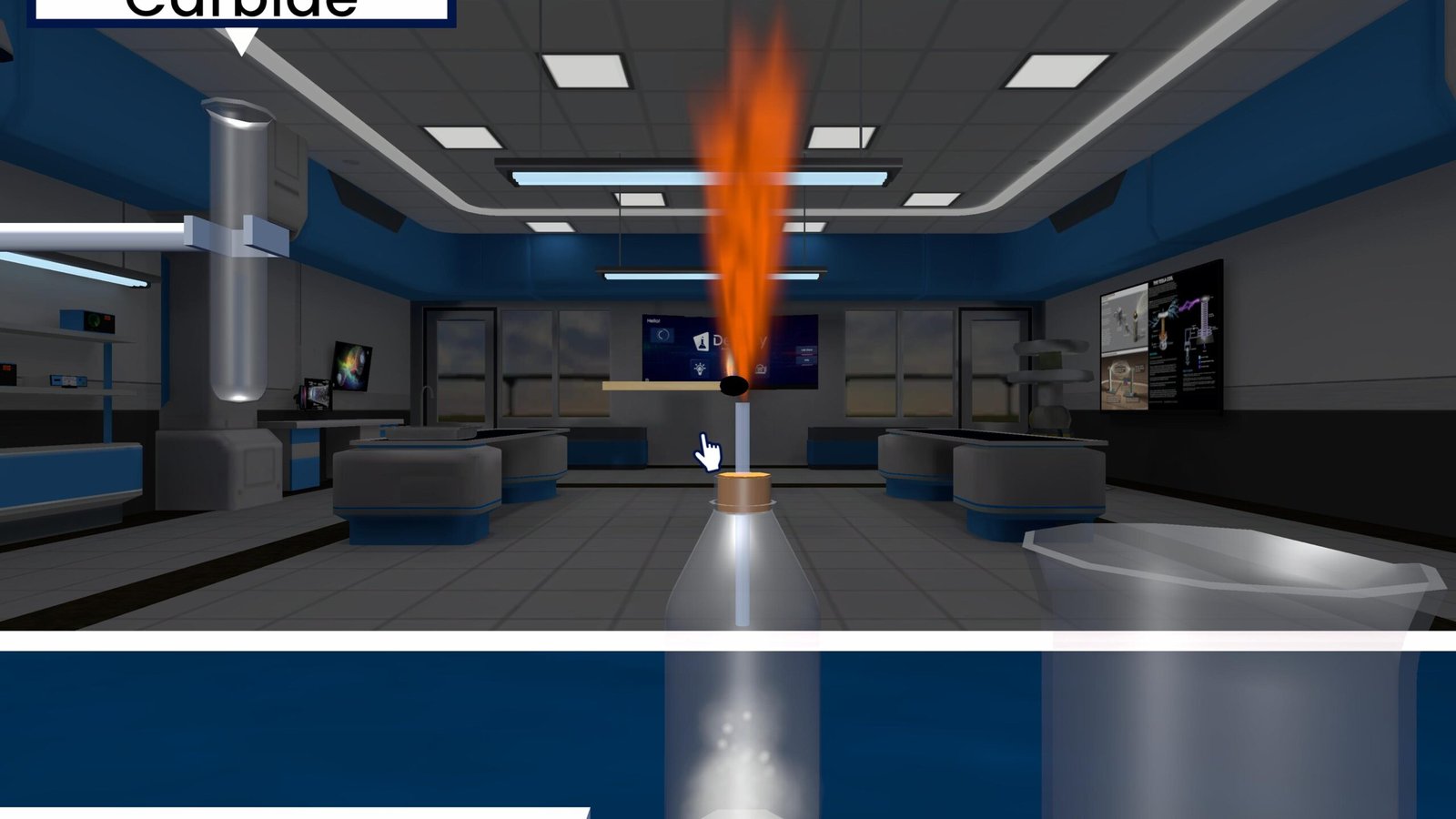Preparation of Ethyne Gas from Calcium Carbide – Experiment
Class: class 11 science
Definition:
When calcium carbide (CaC2) reacts with water, it produces ethyne gas (C2H2) and calcium hydroxide (Ca(OH)2). This reaction is exothermic, meaning it releases heat. The ethyne gas formed is highly flammable and burns with a bright, sooty flame.
Theory: Step-by-Step Breakdown of the Process
This experiment demonstrates a multi-step industrial and laboratory process:
- Heating Limestone (CaCO3):
When heated strongly, calcium carbonate (limestone) decomposes into quicklime (CaO) and carbon dioxide (CO2).- Reaction: CaCO3 → CaO + CO2
- Formation of Calcium Carbide (CaC2):
Quicklime is then combined with coke (carbon) in an electric arc furnace to produce calcium carbide and carbon monoxide (CO).- Reaction: CaO + 3C → CaC2 + CO
- Reaction of Calcium Carbide with Water:
When calcium carbide is added to water, it reacts vigorously to form ethyne (acetylene) and calcium hydroxide.- Reaction: CaC2 + 2H2O → C2H2 + Ca(OH)2
This last step is what is typically done in the school lab. Ethyne gas is colorless with a faint garlic-like odor and very flammable. The calcium hydroxide formed is slightly soluble in water and makes the solution alkaline.
Real-Life Uses of Ethyne and Calcium Hydroxide
- Ethyne in Welding: Used in oxy-ethyne torches to weld and cut metals due to its high flame temperature.
- Carbide Lamps: Ethyne gas was historically used in lamps for miners and cave explorers.
- Organic Chemistry: Ethyne is a starting material in the synthesis of compounds like PVC, acetic acid, and synthetic rubbers.
- Calcium Hydroxide: Commonly known as slaked lime, it’s used in soil treatment, whitewashing, and construction.
Observations
- Heating limestone releases quick lime and carbon dioxide.
- Quick lime and coke in electric arc produce calcium carbide.
- Calcium carbide + water gives ethyne gas and heat.
- Ethyne burns with a bright, sooty (luminous) flame.
Summary Table
| Step | Observation |
|---|---|
| Limestone heated | Produces quicklime (CaO) and CO2 gas |
| Quicklime + coke | Forms calcium carbide (CaC2) |
| CaC2 + H2O | Produces ethyne gas and calcium hydroxide |
| Gas test | Ethyne burns with a bright, sooty flame |
Perform This Experiment Safely with Dencity Virtual Science Lab
With the Dencity app, students can simulate the preparation of ethyne gas and observe each chemical step safely and interactively. No real chemicals, no risk, just learning!
In the Dencity virtual lab, you can:
- Simulate all steps from limestone heating to ethyne gas testing.
- Observe how gas evolves, measure temperature change, and see visual flame tests.
- Explore reaction sequences with interactive animations.
- Learn reaction mechanisms and products in an engaging, student-friendly way.
This experiment is part of class 11 science, and Dencity ensures it’s accessible even in schools without a full chemistry lab.
Dencity for Teachers
Dencity makes interactive teaching seamless and effective:
- Assign the ethyne preparation experiment digitally in seconds.
- Show real-time simulations during class using visual aids.
- Emphasize gas laws, reaction safety, and exothermic reactions.
- Automate student submissions and reports.
- Promote interactive learning without handling dangerous materials.
Fully Compatible with Interactive Touch Panels
Dencity is designed to work perfectly on interactive touch panels in classrooms. Teachers and students can control reactions, adjust variables, and visualize the experiment flow through simple touch gestures — making chemistry lab sessions more immersive and hands-on.
Contact Us for Demo or Customized School Plans
Want to introduce Dencity Virtual Science Lab in your school or institution? Visit dencityapp.in for a custom pricing quote or to schedule a free live demo tailored to your science curriculum.
Frequently Asked Questions (FAQs)
- What gas is produced when calcium carbide reacts with water?
Ethyne (C2H2), a colorless and highly flammable gas. - Why is this reaction called exothermic?
Because it releases heat as the products are formed. - How is calcium carbide made?
By reacting quicklime (CaO) with carbon (C) in an electric arc furnace. - What does ethyne smell like?
It has a faint garlic-like smell. - Why does ethyne burn with a sooty flame?
Due to incomplete combustion, which produces carbon particles (soot). - Is this experiment safe for school labs?
Only under controlled conditions. Safer to explore via Dencity’s virtual lab. - Where is ethyne used in real life?
In metal welding, carbide lamps, and chemical synthesis. - Can this experiment be performed virtually?
Yes! Dencity lets students simulate all steps safely and interactively. - Is calcium hydroxide useful?
Yes, it’s used in agriculture, construction, and cleaning. - How can teachers access Dencity?
Visit dencityapp.in to request access, demos, or pricing.
Dencity — Learn Chemistry Safely, Anytime, Anywhere with Virtual Science Lab Power.







